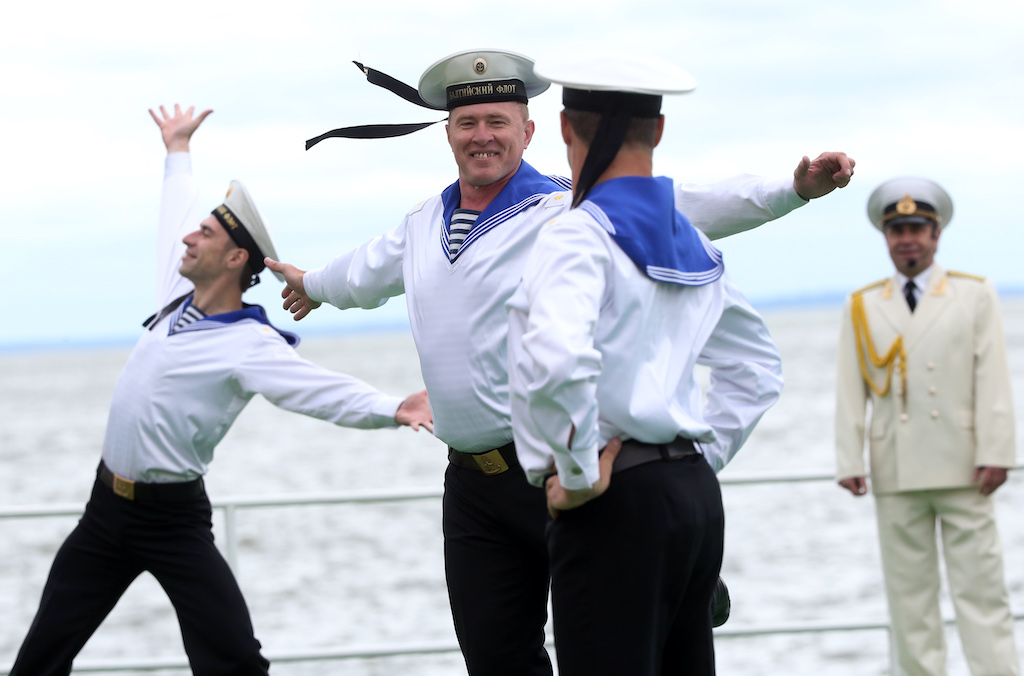Russia’s exclave in Kaliningrad has long given nightmares to NATO’s defense planners. The outcome of the Ukraine war will bear heavily on its future.
 The Kaliningrad garrison serves as an intimidating Russian presence in the Baltic region. The Baltic Fleet, headquartered there, has been significantly upgraded in recent years with new ships, ground forces and missiles. © Getty Images
The Kaliningrad garrison serves as an intimidating Russian presence in the Baltic region. The Baltic Fleet, headquartered there, has been significantly upgraded in recent years with new ships, ground forces and missiles. © Getty Images
- The outcome of the war in Ukraine may seal the future of Kaliningrad
- Russia’s military forces serve as a lock on the Baltic
- The exclave may morph from Moscow’s strategic asset to a liability
NATO military planners have long been concerned about Russia’s strategic Kaliningrad exclave. Wedged in between Poland and Lithuania, the chunk of Russian territory with fewer than half a million people has been a fixture in the security architecture of the Baltic Sea region. During the years leading up to the 2022 war in Ukraine, major Russian moves to upgrade its military presence there have triggered concerns. The scenarios hinge on how that war ends and if the regime in Belarus survives.
The heightened posture featured the introduction of Iskander ballistic missiles that may carry nuclear warheads, combined with Russia’s top-of-the-line S-400 air defense systems and Bastion coastal defense systems. Meanwhile, the ground forces were enhanced with new units, including more and better tanks and artillery. And the Baltic Fleet, also based in Russia’s westernmost town of Baltiysk, received both upgrades and additional ships.
As Russia’s “special military operation” in Ukraine continues to reveal disastrous shortcomings, it is becoming questionable how much of this still matters and if Kaliningrad will play much of a role in the future.
Kaliningrad exclave’s military significance
The main reason why NATO has been so concerned has to do with the exposed position of the two northern Baltic states. As shown in numerous war-gaming exercises, a Russian armed invasion of Estonia, for example, could have been swift and would have presented NATO with a fait accompli. Once it failed to repel the attack, the alliance would find itself in an unenviable position of having to expel the invader to honor its mutual defense obligations under Article 5.
If such a rescue were to be launched over land, it would have to proceed from Poland into Lithuania. NATO forces would need to transit the “Suwalki Gap,” a 70-kilometer stretch of land between Kaliningrad and Belarus, and the opposition would heavily bombard it from both sides. The alternative would be a combined airlift and naval convoy proceeding up the Baltic past Kaliningrad’s missile batteries.
Given that NATO assets attempting to pass through that area would have had to reckon with heavy losses, Kaliningrad served as an intimidating Russian lock on the Baltic. In military jargon, it was an “A2/AD (anti-access/area denial) bubble.” Adding that a Russian attack on one or more Baltic states would likely have been associated with a Russian assault to seize the demilitarized Swedish island of Gotland, strategically located in the center of the Baltic, the double lock seemed to be quite formidable.
With NATO troops present on the ground in Finland, the Russian rear would be dangerously exposed to missile and artillery strikes.
Although no NATO source would have admitted this possibility, Moscow may well have calculated that if it did choose to invade, say, Estonia, NATO would seek and find an excuse to settle the matter without the use of force. In the case of Finland and Sweden in NATO, that calculus changes beyond recognition.
Enter Finland and Sweden
It is true that Russia has long viewed both countries as de facto NATO members and that despite their nonaligned status, NATO troops would still have been able to come to the rescue of the Baltics via the Swedish and Finnish territories. But there are three important points to be made here.
One is that with NATO troops present on the ground in Finland, the Russian rear would be dangerously exposed to missile and artillery strikes. Another is that the Swedish and Finnish air forces, which now have ample experience in joint operations, would constitute a formidable problem for Russian aviation. And the third important circumstance is that the Swedish navy has advanced submarines that could swiftly take on the dual task of eliminating any Russian naval opposition and aggressively mining the approaches to St. Petersburg, including the Russian naval base in Kronstadt.
This enhancement in the ability of NATO to protect Estonia and Latvia will significantly reduce the importance of Kaliningrad. While this will erode the incentive for Russian military planners to invest in keeping it up to scratch, the garrison there will remain consequential. It retains its strategic location in the southern Baltic, and it has the capability of launching nuclear missile strikes against Warsaw, an option that has featured in war games.
However, from the Kremlin’s distant horizon, Kaliningrad could be transformed from an asset into a liability. The outlook features very different scenarios where the critical feature concerns what will happen in Belarus.
Pushing back Russia
The first scenario emerges if a decisive Russian defeat in Ukraine leads to a collapse of the regime of strongman Alexander Lukashenko. A cessation of economic support from Russia to Belarus could prompt a cascading crisis, strikes and civil unrest, with parts of the armed forces eventually switching their allegiance. Battle-hardened Belarusian volunteer forces that have fought against the Russians in Ukraine could be decisive here, returning home to help expel all remaining Russian troops from Belarus.
If Belarus switched sides, the consequences for the Russian garrison in Kaliningrad would be immense. Already depleted from having contributed troops to the war in Ukraine, the military outpost would find itself surrounded by hostile forces. As Russia’s borders in the West would be pushed back to roughly where they were at the end of the 16th century, the “Suwalki Gap” would cease to matter. Lines of communication between Poland and Lithuania – and points further north – would be wide open.
Defense consequences
Having already declared Russia a terrorist state and branded Russian warfare in Ukraine as genocide, the government in Lithuania could be expected to join Poland in putting a squeeze on Kaliningrad. It would not result in the exclave becoming formally demilitarized, but, over time, the situation of its garrison would come to resemble that of the Russian outpost in Transnistria in Moldova.
The military would become degraded. Even if Russia had resources to spare for Kaliningrad, which is doubtful, military planners would be constrained by the prohibition of transporting troops or military hardware over land. With the Baltic Sea in the hands of NATO, resupply by sea would be at the mercy of the alliance. With sophisticated missiles stationed on the Swedish island of Gotland, the airspace would also belong to NATO.
Economic deterioration
The exclave’s economy would become equally degraded. The sanctions regime would block all forms of imports over land, leaving shipping as the only lifeline, and Russian ships would have a hard time finding foreign ports at reasonable distances that would receive them. Shortages would become ubiquitous.
In consequence, the local population would find everyday life increasingly complicated. Those employed in the dominant military sector would feel the squeeze of dwindling payments from Moscow. At the same time, those living off border trade would no longer be able to continue such operations.
Under this broad scenario, Kaliningrad would fizzle into irrelevance. With its nuclear weapons eventually removed, the Baltic Sea region would enjoy peace and stability.
Russia prevails
An alternative scenario would occur if the Western resolve to stand by Ukraine erodes over time, and Kyiv is forced to accept a settlement. A deal between the European Union and Russia could end hostilities and cause a withdrawal of Russian forces from much of Ukraine. The price for that would be allowing the Kremlin to retain control over the Crimean Peninsula and Donbas (at least), plus most likely also the coastline up to, and possibly even beyond, Crimea.
Such an outcome would allow the Russian regime to save face, thus removing the threat of regime change via a coup. It would also be associated with a gradual lifting of sanctions to allow Russia to resume cooperation with its former European partners. And it would be associated with Belarus remaining within the Russian camp, fostering even deeper bonds between the two militarized autocracies.
If the Lukashenko regime survived, it may be expected to deal harshly with those who sought to undermine the Russian war effort in Ukraine, ranging from volunteer forces to railway saboteurs and civil society activists. Increased repression would feature the use of the recently reintroduced death penalty and possibly even assassinations of opposition figures abroad. The potential implications for Kaliningrad are considerable.
Regaining strength
As Russia recovered its economic strength, buoyed by continued energy exports to Europe and a resumption of trade that has European industry majors returning to the Russian market, it would also be able to start rebuilding its military capabilities. Embittered by its humiliation in Ukraine, the Kremlin would be prone to use the Belarus-Kaliningrad axis to drive home that its voice must still be heeded.
Given that a negotiated settlement of the war would still be associated with a heavy buildup of NATO forces along Russia’s western borders, and that its conventional military hardware has proven inferior to NATO weapons, Russian planners would be escalating their already loud nuclear saber-rattling.
Kaliningrad would be assigned a critical role in this endeavor. The exclave’s land-based Iskander missiles constitute a lethal threat to Poland. The Baltic Fleet has missile corvettes that may launch nuclear-capable Kalibr cruise missiles capable of striking land targets at 1,500-2,500 kilometer-distance and Kh-35 cruise missiles that may strike enemy ships. If these forces are maintained and upgraded, peace and security in the Baltic Sea region come under a very dark cloud.
Perpetual threat
A middle-of-the-road outcome is possible, where Russia suffered a decisive loss in Ukraine, but Belarus still manages to muddle through. Under this script, the country offers the Kremlin a vantage point to extend future influence toward Kaliningrad and the EU. But it would be a weak link, in constant danger of breaking.
The obvious alternative to a clear Russian defeat is a dubious deal. Western resolve could dissipate over time. The leading European powers may succeed in brokering a “peace” plan that would allow Russia to retain a hold over Ukraine and Belarus to remain in the Russian camp. This scenario ensures access to resources for Russian leaders bent on seeking revenge.


